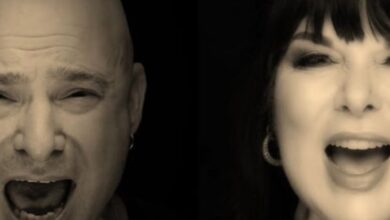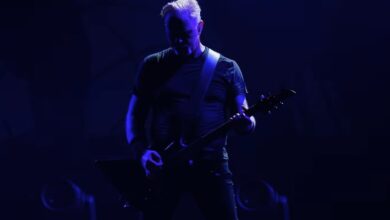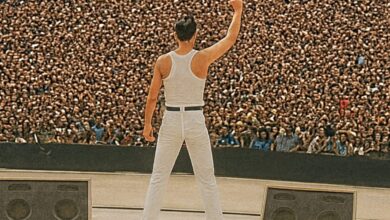Brian May & Andrea Bocelli Honor Freddie Mercury with a Stunning “Who Wants To Live Forever” Performance
The open-air stage of Teatro del Silenzio in Tuscany has always promised spectacle, but on a warm July night in 2024, something extraordinary unfolded. Andrea Bocelli’s anniversary concert already carried the weight of history, yet the atmosphere shifted the moment a familiar guitar silhouette appeared beside him. Brian May, legendary guitarist and original composer of “Who Wants to Live Forever,” stepped into the spotlight, greeted by cheers that rolled across the hillside. The anticipation felt electric, the kind that signals a moment destined to be remembered long after the night ends.
Bocelli began with his signature elegance, shaping each line of the melody with careful breath and luminous tone. His voice, rich and full of vulnerability, gave the song a new emotional layer, one rooted not in rock intensity but in classical longing. As he delivered the opening verses, the amphitheater quieted into reverence, the audience sensing that this was not just a performance—it was a conversation across genres, eras, and hearts.
Then May entered vocally, his harmonies rising like a cherished memory. There was something profound about hearing the songwriter reclaim the piece in a setting so far removed from its original stadium-rock DNA. Even at 80, his tone carried command and warmth, the signature human cry behind his guitar shining through every phrase. Side by side, the tenor and rocker built a sound that felt both intimate and monumental, honoring the song’s roots while evolving its meaning.
The orchestration mirrored the drama of the original arrangement while adapting to Bocelli’s world—strings sweeping like wide Tuscan horizons, percussion emerging with subtle authority. Each swell heightened the emotional stakes of the song’s central question: how fragile, and how precious, the time we have with those we love. Under the open sky, the lyrics gained new weight—less cinematic fiction, more universal truth shared among thousands of listeners breathing the same air.
Brian May’s guitar became the thread binding everything together. The distinctive voice of his Red Special cut through the orchestral blend with a purity that brought fans to tears. His melodic lines didn’t shout for attention—they soared, like beams of light piercing through the night. Watching him take his place among the strings and voices reminded everyone that rock and classical music are not opposites; they are siblings separated only by instrumentation.
There was also tenderness in the non-musical details. Between phrases, May shot glances toward Bocelli—small smiles of mutual admiration that said more than any scripted introduction. Bocelli responded with gestures that made it clear how honored he felt to share the song with the man who wrote it. Those quiet moments, unpolished and real, fused the performance with authenticity that amplified the music’s emotional impact far more than spectacle ever could.
Front-row audience members later described the duet as the emotional high point of the entire celebration. The theater fell silent for the last long-held note, a silence that wasn’t empty but overflowing—grief, joy, nostalgia, and gratitude all compressing into a single breath. When the applause finally erupted, it wasn’t simply excitement; it was release. People stood not only for virtuosity but for what the performance represented: two lifelong artists uniting over a song that wrestles openly with mortality.
The setting played a starring role in its own right. Teatro del Silenzio, carved into the landscape near Bocelli’s hometown, combines natural acoustics with sweeping scenery. The moonlit hills became part of the staging, amplifying the song’s themes of eternity and impermanence. No arena could have delivered the same sensation of openness—no roof to contain the chorus, no barrier between music and the wide universe above. It was the perfect stage for a song about love stretching beyond time.
After the concert, viewers across the world discovered the moment through professionally released footage. Many were struck by how beautifully the video captured the expressions on both musicians’ faces—the quiet pride in May’s eyes as Bocelli lifted the melody, the full-hearted concentration Bocelli held through every sustained note. Fans felt invited into the experience, not as distant spectators but as part of a global audience sharing the same awe.
Reactions poured in from every corner of the internet. Longtime Queen fans marveled at how May’s presence rekindled memories of Freddie Mercury, while Bocelli’s audience praised the emotional clarity he brought to the lyrics. Even those unfamiliar with the song’s history found themselves moved to tears. It wasn’t nostalgia alone that carried the performance—it was the undeniable force of two masters blending their crafts into something fresh, truthful, and unforgettable.
The collaboration demonstrated how music can bridge worlds without asking either side to compromise. Bocelli didn’t suddenly become a rock singer, and May never abandoned the spirit of Queen. Instead, they met in the center point where passion, melody, and storytelling unite. The message was simple yet powerful: when artistry leads, genres follow—and humanity is what remains. Anyone lucky enough to witness it that night in Tuscany felt the truth of that message resonate deep in their bones.





